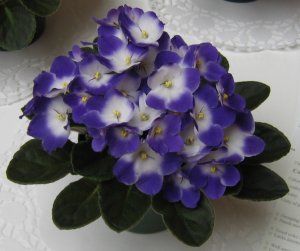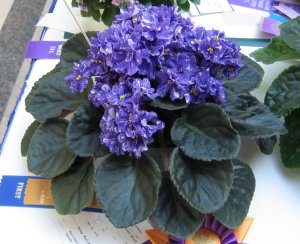Hybridization
 The
wide variety of blossom and foliage types now seen in African violets is the
result of the efforts of hybridizers and growers who have saved successful
new mutant plants.
The
wide variety of blossom and foliage types now seen in African violets is the
result of the efforts of hybridizers and growers who have saved successful
new mutant plants.
Hybridization - Some Key Dates:
1926 - Armacost & Royston, Los Angeles, import seed.
1935 - Armacost & Royston release first 10 varieties.
1939 - First double-blossomed plant appears.
1942 - First true pink blossom appears from seed.
1943 - First true white blossom appears from seed.
1951 - First miniature hybridized by Frank Tinari.
1952 - First white-edged blossom appears.
1953 - First star blossom (equal size petals) appears.
1954 - First pink double hybridized by Lyndon Lyon.
1957 - First trailing African violets hybridized
1960 - Crown variegation appears.
1961 - Mosaic variegation appears.
1967 - "Tommie Lou" variegation appears.
1974 - Lyndon Lyon hybridizes first miniature trailer.
1992 - First yellow blossomed plants hybridized.
As we pass the 120th anniversary of the discovery of African violets in the
wild, we have an amazingly wide colour selection in African violets with
many shades within the colours. Moreover, there are plants with white edges,
coloured edges, dots and streaks in different colours or hues, just to name
a few of the variations. There is also a wide variety of leaf shades (to say
nothing of shapes) including the white, pink and cream variegates. We could
not say the same of the wild species violets which characteristically had
blue flowers, green leaves — usually dark green.
How then did the incredible variety of African violet cultivars come about
if the species parentage was so simple and so pretty but plain? The answer
is the hybridizer or hybridizers for there have been, are and will be many
of them. While the name "hybridizer" sounds ominous it is really just a
person like you or us who has a penchant for hybridizing. Hybridizing is the
art or science of crossbreeding plants of genetically dissimilar species or
varieties to produce offspring that are very different in appearance and
growth habit. We owe this wonderful palette of colour to the dedicated men
and women who have worked patiently with their favourite plant over many
decades.
Blossom Types and Colours
In the beginning hybridizers crossbred African violet species with some
basic similarities to get more robust offspring with better but still basic
blue blossoms. Of course, they hoped to bring some colour variety to their
chosen plant. They had to wait for a while to let the plant reveal its
genetic secrets gradually and to betray its tendency to produce sports or
mutants exhibiting desirable characteristics.
It is reported that wine-reds, whites and pinks appeared very early in trays
of plants grown from seed in Germany. However, our heritage of varieties in
these colours comes from the American hybridizers working in the 1930's and
1940's. To these colours were added ultimately the harder to achieve coral
pink and coral red. The latest colour discovery has been yellow. For many
years violet-lovers have been hoping to have the palette available broadened
to include the remaining part of the spectrum, specifically yellow and true
red as opposed to the wines, burgundies and fuchsias so common in violet
blossoms. What a surprise they got a few years ago when Nolan Blansit
introduced them to the first true yellows. Still the newborn of the colour
family, yellow is hard to find.
In addition to increasing the colour range, hybridizers have also come up
with multi-coloured blossom types, bloom edged in contrasting colours,
striped and spotted blooms. Other characteristics they have tackled include
petal count, blossom count, blossom shape, and so on.
Leaf Types and Variegation
Leaf-type has also been varied by the hybridizers. There is a natural
variance in violets in the shade of green, the colour of the leafback and
so on. Hybridizers have taken advantage of this to produce varieties with
intensely dark green leaves with red backs, for example. The biggest
happening in regard to leaves, however, was the development of variegation.
A variegated leaf is basically a green leaf with markings in white, pink or
some other contrasting colour. Many houseplants have had a variegated
variety for some time; some variegates even occur in nature. The African
violet was not among these for a long time. A few variegated baby plants
showed up from time to time but the variegation was unstable. What a
surprise Mrs. Tommie Lou Oden had one day when she found a variegated baby
plant growing in a clump of new plants from a mother leaf of an old variety
called "White Pride". Knowing that variegated violets had a bad reputation,
Mrs. Oden propagated her plant through many generations. To her surprise the
variegation was stable. The plant was ultimately registered with the African
Violet Society of America and named, appropriately, "Tommie Lou". "Tommie
Lou" is the (many times over) grandmother or great-grandmother of every
plant you see exhibiting the leaf-edge type of variegation. Note that she is
the "grandmother", never the "grandfather" as variegation is a
characteristic passed on through the female line only.
There are two other types of variegation seen less frequently. One is mosaic
variegation, often called "Lillian Jarrett" variegation, which presents a
mosaic of white dots and splashes on the leaves. The other is called crown
variegation. A crown-variegated plant has a white or light-coloured centre
crown surrounded by increasingly darker green leaves at the edge. The young
leaves become greener as they age and progress to the outer rows of leaves.
Size and Types of Plants
Hybridizers have also brought us different sizes of plants and plants with a
trailing growth habit. Some of the wild species have a smaller size. By
crossbreeding these with the standard size hybrids which had been developed
they came up with the whole range of miniature and semi-miniature African
violet varieties. These have been a great boon to growers with limited space
as they can fit a large number of these small plants into the space occupied
by a few standards. They are not short-changed on bloom or beauty. Many of
the small plants are extremely floriferous and the range of the bloom type
and colour equals that of the standards.
The trailing growth habit has been added to the modern varieties of the
African violet again by going back to the species and crossing those that
had a trailing growth habit with certain of the modem varieties and thereby
transferring the modern blossom types to a plant which grow into a gracefully
trailing multi-crowned plant.
Chimeras
Finally, the most spectacular of all African violet blossoms are found on
the plants we call chimeras. These are the pinwheel-striped blooms which
draw more gasps of delight and amazement than any other type. Chimeras are
genetic freaks which have turned up in the hybridization and propagation
processes. Occasionally a chimera will turn up as a small plant grown from
seed by the hybridizer. It may also turn up as a sport in a batch of new
baby plantlets grown by leaf propagation. Chimeras are accidents and the
hybridizer cannot really plan for one. However, their presence among African
violet varieties is still the product of the hybridizer's work.




